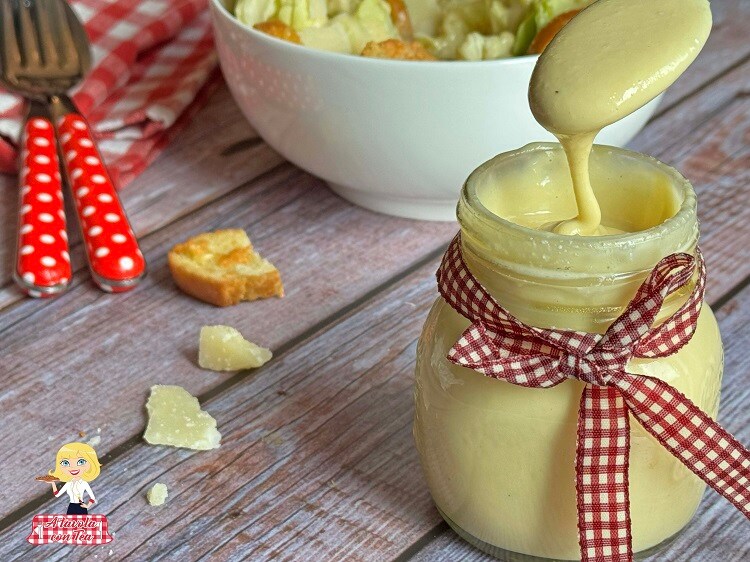HOMEMADE CAESAR SALAD DRESSING Creamy and Genuine
Tired of the usual store-bought Caesar dressings, often filled with mysterious ingredients and standardized flavors? It’s time to revolutionize your salad! With this super easy recipe, you’ll prepare a homemade Caesar Dressing that will surpass any version bought or tasted at a restaurant! Yes, you heard right: a rich, umami, and authentic taste, customizable to your preferences.
Preparing dressings from scratch, like the Classic Salad Dressing, is surprisingly simple, and our creamy Caesar dressing is no exception. Forget about blenders and food processors that make a mess and complicate things: this recipe is designed to be made in just one bowl, with a simple hand whisk. Measure, pour, mix… and here you have a thick and enveloping dressing, rich in aromatic notes from fresh garlic, lively lemon juice, and plenty of Parmesan.
This dressing is a true kitchen joker and will become the secret of your classic Caesar salad, transforming a simple crispy romaine lettuce and homemade croutons into a gourmet dish.
Thanks to its stability and texture that remains intact, you can enjoy it directly from the refrigerator without it separating. A touch of umami, a citrusy note, and the perfect creaminess: get ready to fall in love with your new favorite Caesar dressing!

- Difficulty: Very Easy
- Cost: Affordable
- Preparation time: 15 Minutes
- Portions: 10
- Cooking methods: No Cooking
- Cuisine: American
- Energy 132.27 (Kcal)
- Carbohydrates 2.70 (g) of which sugars 0.14 (g)
- Proteins 2.19 (g)
- Fat 13.07 (g) of which saturated 2.58 (g)of which unsaturated 0.51 (g)
- Fibers 0.35 (g)
- Sodium 81.12 (mg)
Indicative values for a portion of 25 g processed in an automated way starting from the nutritional information available on the CREA* and FoodData Central** databases. It is not food and / or nutritional advice.
* CREATES Food and Nutrition Research Center: https://www.crea.gov.it/alimenti-e-nutrizione https://www.alimentinutrizione.it ** U.S. Department of Agriculture, Agricultural Research Service. FoodData Central, 2019. https://fdc.nal.usda.gov
Caesar Salad Dressing Ingredients for about 1.5 cups of dressing
- 1 cup cup mayonnaise
- 2 tsp Dijon mustard
- 2 tsp Worcestershire sauce
- garlic (2 cloves grated or pressed)
- 3 tbsp tbsp lemon juice
- 1/2 tsp fine salt
- 1 pinch black pepper
- 1/2 cup cup extra virgin olive oil
- 1/2 cup cup grated Parmesan cheese
Tools
- Kitchen Scale
- Bowl
- Hand Whisk
How to Make Caesar Salad Dressing
To prepare the Caesar Salad dressing, you can either use a simple bowl and a hand whisk, or if you want to be faster, an immersion blender.
In a large bowl, combine the mayonnaise, Dijon mustard, Worcestershire sauce, grated or pressed garlic, fresh lemon juice, fine salt, and freshly ground black pepper. Using a hand whisk, vigorously whisk all these ingredients until they are well blended and have a homogeneous consistency.
While continuing to whisk vigorously with the whisk, start slowly drizzling in the olive oil into the mixture. The key to getting a thick and well-emulsified dressing is to pour the oil very gradually, blending it forcefully with the other ingredients. Keep whisking until all the oil is incorporated and the dressing is creamy and glossy.
Finally, add the freshly grated Parmesan cheese to the dressing. Whisk vigorously to incorporate the cheese and ensure it is evenly distributed. Your Caesar dressing is ready!

Transfer the prepared dressing into a glass jar with a tight-fitting lid. Store it in the refrigerator until ready to use. This dressing will maintain its creamy consistency even when cold, so you can use it directly from the refrigerator without needing to re-emulsify it. Remember to label the jar with the preparation date to keep track of freshness.

NOTE on Ingredients and Substitutions
Mayonnaise: Use a good quality mayonnaise, preferably the “real” kind (egg-based) for the best consistency and flavor. The eggs in mayonnaise act as a natural emulsifier, ensuring that the dressing stays thick and doesn’t separate. If you love the taste, a homemade mayonnaise will further elevate your dressing.
Dijon Mustard: Adds a touch of spiciness and depth of flavor, as well as being a natural emulsifier. Any brand of Dijon mustard will do.
Worcestershire Sauce: This ingredient is key for the rich and complex umami flavor of the Caesar dressing.
Note for Vegetarians/Fish Allergies: Traditional Worcestershire sauce contains anchovies. If you are vegetarian or have a fish allergy, look for vegan or vegetarian versions of Worcestershire sauce that do not include them among the ingredients.
Extra Light Olive Oil: It is essential to use a neutral-flavored oil, like extra light olive oil, sunflower oil, or canola oil. Extra virgin olive oil, with its more robust flavor, would alter the classic flavor profile of the Caesar dressing.
Garlic: Always use fresh, grated, or pressed garlic for the maximum flavor. Powdered garlic or pre-prepared garlic in a jar won’t give the same “punch”.
Fresh Lemon Juice: Freshly squeezed lemon juice is essential for the acidity and freshness that balance the richness of the dressing. Avoid lemon juice from concentrate, which has a less lively flavor.
Parmesan Cheese: Use freshly grated Parmesan for the best flavor. It can be finely grated or more coarsely, depending on your texture preference. You can also use Grana Padano.
Storage
Transfer the homemade Caesar Dressing into a glass jar with a tight-fitting lid or a sealable container. Store it in the refrigerator for up to a week. Its creamy consistency will remain intact even when cold, and you can use it directly from the refrigerator without needing to blend or re-emulsify it. Remember to put it back in the refrigerator immediately after use to maintain its freshness.
Recipe Alternatives and Variants
This dressing is already a classic, but you can slightly personalize it:
With Anchovies (Traditional): If you love the authentic anchovy flavor, you can add 1-2 finely chopped anchovy fillets (or 1/2 teaspoon of anchovy paste) and incorporate them in the first step along with the other liquid ingredients. Although Worcestershire contains anchovies, the direct addition will make them more present.
Fewer Calories: For a slightly lighter version, you can replace half of the mayonnaise with plain Greek yogurt (low-fat). The consistency might be less dense.
Fresh Herbs: Add a teaspoon of finely chopped fresh parsley or a pinch of fresh thyme for a herbal note.
Spicy Touch: A pinch of red chili powder or a few drops of Tabasco can add a bit of zing.
Lactose-Free: Substitute the Parmesan cheese with an aged lactose-free cheese (e.g., some types of Pecorino) or omit it, although the flavor will suffer. Ensure that mayonnaise and Worcestershire sauce are lactose-free.
Origins and History of Caesar Dressing
The Caesar salad dressing and Caesar Salad have a fascinating history that is not related to the Roman Emperor Julius Caesar, but rather to an Italian-American restaurateur named Caesar Cardini. Legend has it that in 1924, during a busy weekend at his restaurant in Tijuana, Mexico (where he had moved to escape Prohibition), Cardini found himself with few ingredients available and improvised a salad with what he had: romaine lettuce, olive oil, raw eggs, lemon juice, Parmesan cheese, Worcestershire sauce, and croutons.
The innovative touch was the presentation and the way of dressing: the ingredients were prepared at the table, mixing everything on the spot. The salad became an immediate success, attracting even Hollywood stars who crossed the border. Although Cardini’s original recipe was slightly different (it seems it didn’t include anchovies in the dressing, but the umami flavor was given by Worcestershire and eggs), the version with anchovies or anchovy paste has become very popular over time. Its fame spread quickly, making it one of the most loved and recognized salad dressings in the world.
FAQ (Questions and Answers)
1. Does the dressing thicken once refrigerated?
Yes, absolutely! The Caesar dressing, once stored in the refrigerator, tends to thicken further as the oil cools. This is a normal and desirable behavior. It does not separate and will remain creamy, ready to be used directly from the fridge.
2. Can I use a blender instead of a whisk to prepare the dressing?
Certainly! Although the recipe is designed for preparation in a single bowl with a hand whisk for simplicity and less mess, you can easily use a blender, a food processor, or an immersion blender. This will make the dressing even smoother and more emulsified, although you may need to scrape the sides to ensure all the ingredients mix well.
3. Why is extra virgin olive oil not recommended?
Extra virgin olive oil has a much stronger and more characteristic flavor compared to extra light olive oil or other neutral oils. If used in Caesar dressing, its intense taste would tend to cover and alter the delicate and balanced flavor profile obtained with garlic, lemon, and Parmesan, not doing justice to the classic dressing flavor.

